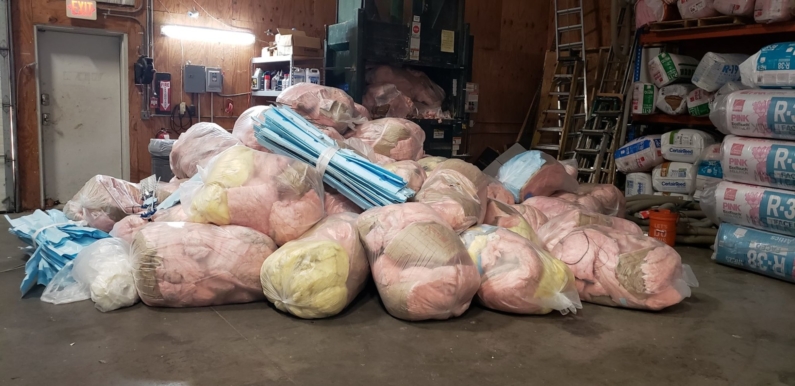We recently got a call from a homeowner who wanted their attic insulation replaced. Their old fiberglass insulation was wet and dirty and needed to be replaced. Not only that, it had originally been installed upside down, leading to moisture problems. We weren’t surprised by this situation as we get calls for help all the time. Our advice is to do it right the first time. That’s why we say, “Don’t use fiberglass insulation!!
In cold climates fiberglass just won’t do
Fiberglass insulation is significantly cheaper than spray foam insulation, but it is also less effective, especially in extremely warm conditions. Summers in New England regularly hit above 100°F. Spray foam is more expensive, but you get your money back within five years.[1]
Used in roughly 85% of American homes, fiberglass insulation is the most common form of home insulation. Spray foam insulation has less market share, but is increasing in popularity.[2] Why? Because it is MUCH better and you pay once. Professional installation is required for spray foam insulation, but hey, would you have the plumber fix your broken tooth?
Energy efficiency of fiberglass vs. spray foam
The composition of fiberglass insulation does not stop air from passing through it. On average, more than 30% of heat or air conditioning escapes where fiberglass insulation is installed. If poorly installed, fiberglass can also leave spaces around fixtures, allowing even more heating or cooling to escape.
Spray foam insulation fills all spaces, preventing air from escaping. It acts as an air barrier. Spray foam insulation is significantly more efficient than fiberglass and has a higher R-value.[3]
Problems with fiberglass
Incorrect installation – Failing to fill the wall cavities and compressing the batts are two of the most prevalent installation mistakes. They’re also the leading causes of poor performance, which is why some green building consultants, architects, and builders recommend other products. Their answer for total fill: cellulose.[4]
In a recent project we repaired, the insulation was originally installed incorrectly. As a matter of fact, because it was installed incorrectly, the vapor barrier (the brown paper side) couldn’t do its job – to trap moisture against the floor. The raft paper has to be facing the conditioned space, in this case the attic floor.
It’s cheap – That means that many home builders can offer it to reduce the cost of the home. But don’t be fooled. You may pay less now, but you’ll pay more later, for sure.

Rodents love it! – Rodents prefer safe, warm, and sheltered environments – making the inside of your walls and attic the ideal home. Insulation that can be found in these places can be even more inviting since it is a source of warmth for the scurrying critters. The malleability of fiberglass insulation makes it easy for a nest to be made, and insulation can be moved where ever needed. Once one nest is established and a rodent is comfortable enough, a colony of rodents can soon follow. With the displacement of materials, you could see a difference in the heating as warm air can now escape from your house in those areas.[5]
Length of life
Fiberglass insulation can last several years, but during that time it loses its effectiveness and you never have a complete seal against air flow. The level of effectiveness also depends if any moisture is present. You may need to replace this type of insulation or add to it as it settles and deteriorates over time.
Spray foam, on the other hand, can last as long as 80 years or more. It’s a much more permanent and effective option. While you’ll pay more up front, the longevity and efficiency of spray foam make it a very cost-effective option. [6]
In closing, when it comes to which is best in the spray foam insulation vs. fiberglass debate, spray foam wins, hands down. If you’re a DIYer, you may be used to installing fiberglass insulation. But if you’re looking for something that will last a lifetime, let a professional install spray foam. [7]
[1] The Green Cocoon (2019). Invest in Insulation. Retrieved from thegreencocoon.com.
[2] Diffen (2019). Fiberglass Insulation vs. Spray Foam Insulation. Retrieved from diffen.com.
[3] Diffen, Fiberglass
[4] Probuilder (2015). Home Insulation Choices: Fiberglass, Cellulose, or Foam? Retrieved from probuilder.com.
[5] Apple Pest Control (2017). Rodents and Your Insulation. Retrieved from applepestcontrol.com.
[6] Good Life Energy Savers (2018). Spray Foam Insulation vs Fiberglass: What’s the Difference? Retrieved from goodlifeenergysavers.com.
[7] Good Life Energy Savers. Spray Foam






